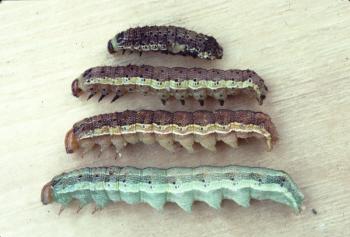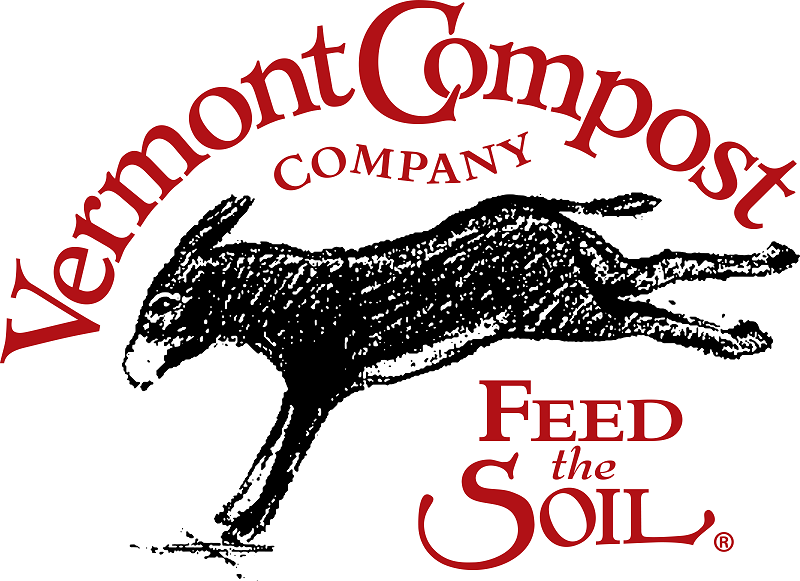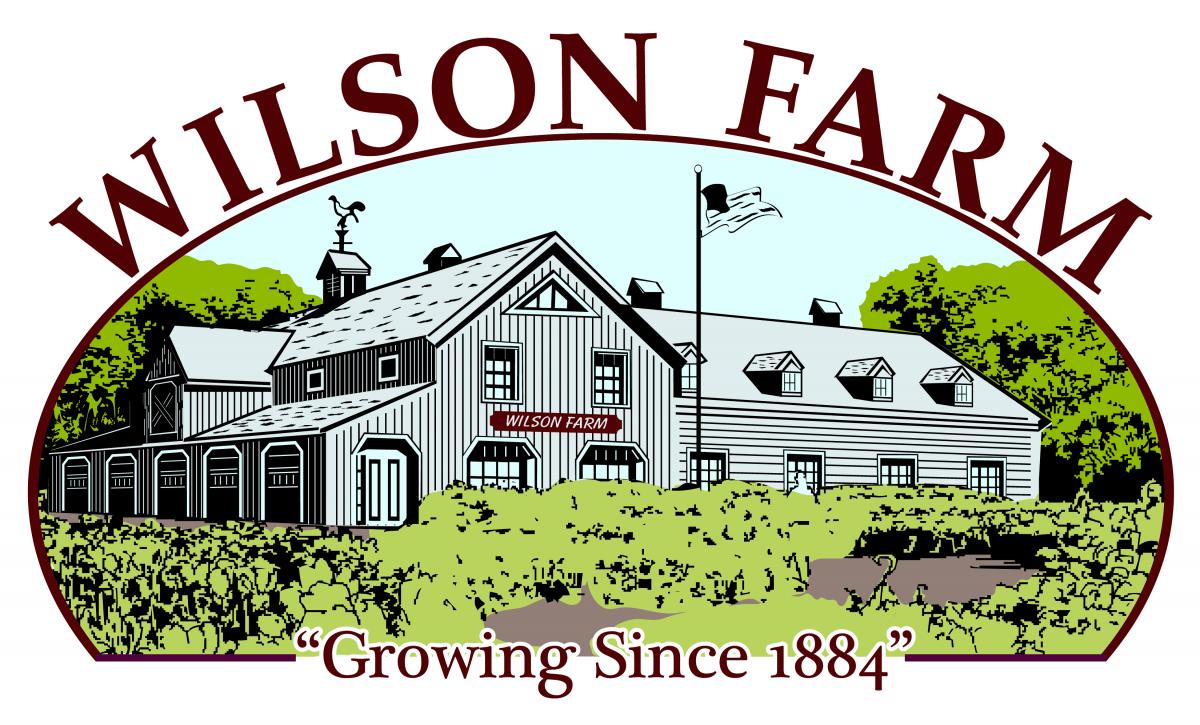To print this issue, either press CTRL/CMD + P or right click on the page and choose Print from the pop-up menu.
Click on images to enlarge.

Crop Conditions
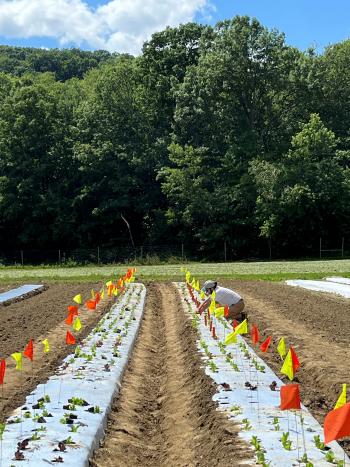 There is so much beautiful produce coming in now and market shelves and wholesale bins are overflowing. Melons are ripe, marking a shift toward big bulk harvests. Continued intermittent storms have left a patchwork of nicely moistened and utterly muddy fields across the state. High humidity has led to much disease development over the last two weeks and we are seeing foliage and fruits succumb to damage from bacterial and fungal pathogens. Unlike insect pests whose activity can be fairly easily monitored visually, pathogens grow unnoticed for 7-10 days before the first leaf spot or soft rot symptoms can be seen. Because of this difference, you can scout for insects and wait to spray until a damaging threshold is reached, but for diseases, you need to spray before you see any signs of disease. Treatments should be based on your past experience with disease on our farm, your understanding of the conditions that favor that disease, and knowledge of its development nearby. It can feel difficult to decide to take the time and resources to spray something you cannot see, but it is the only way to control diseases successfully using fungicides, whether organic or conventional products are used. For tomato crops in particular, for which there are many foliar diseases that can also affect fruit quality, it is definitely time to get on a regular spray program if you have not done so already. Same goes for cucurbit crops, as powdery mildew populations are ramping up, downy mildew is nearby, and reports of Plectosporium, anthracnose, fruit rots and leaf spots are coming in from around the region.
There is so much beautiful produce coming in now and market shelves and wholesale bins are overflowing. Melons are ripe, marking a shift toward big bulk harvests. Continued intermittent storms have left a patchwork of nicely moistened and utterly muddy fields across the state. High humidity has led to much disease development over the last two weeks and we are seeing foliage and fruits succumb to damage from bacterial and fungal pathogens. Unlike insect pests whose activity can be fairly easily monitored visually, pathogens grow unnoticed for 7-10 days before the first leaf spot or soft rot symptoms can be seen. Because of this difference, you can scout for insects and wait to spray until a damaging threshold is reached, but for diseases, you need to spray before you see any signs of disease. Treatments should be based on your past experience with disease on our farm, your understanding of the conditions that favor that disease, and knowledge of its development nearby. It can feel difficult to decide to take the time and resources to spray something you cannot see, but it is the only way to control diseases successfully using fungicides, whether organic or conventional products are used. For tomato crops in particular, for which there are many foliar diseases that can also affect fruit quality, it is definitely time to get on a regular spray program if you have not done so already. Same goes for cucurbit crops, as powdery mildew populations are ramping up, downy mildew is nearby, and reports of Plectosporium, anthracnose, fruit rots and leaf spots are coming in from around the region.
Pest Alerts
Basil
 Downy mildew was observed in Dukes Co. last week on an unknown variety of basil. Basil downy mildew overwinters in southern states where basil is grown year round and blows northward on storm fronts throughout the summer. It can also be carried northward on infected transplants. Growing resistant varieties starting in July is the best management practice. Based on varietal responses in UMass trials, a recommended combination is to grow Prospera and Passion, and then introduce the new Prospera Active (which contains a 2nd BDM resistance gene in addition to the gene in the original Prospera) later in the season. Conventional growers can increase their protection with fungicides. Effective materials include Quadris, Reason, Revus, Orondis Gold, Orondis Opti, Ranman, and phosphorous acid fungicides. For more information on BDM-resistant basil varieties and labeled fungicides, see our article in the December 14, 2023 issue. Let us know (umassveg@umass.edu) if you see downy mildew on any of the resistant varieties this summer so that we can help track the evolution of this important pest.
Downy mildew was observed in Dukes Co. last week on an unknown variety of basil. Basil downy mildew overwinters in southern states where basil is grown year round and blows northward on storm fronts throughout the summer. It can also be carried northward on infected transplants. Growing resistant varieties starting in July is the best management practice. Based on varietal responses in UMass trials, a recommended combination is to grow Prospera and Passion, and then introduce the new Prospera Active (which contains a 2nd BDM resistance gene in addition to the gene in the original Prospera) later in the season. Conventional growers can increase their protection with fungicides. Effective materials include Quadris, Reason, Revus, Orondis Gold, Orondis Opti, Ranman, and phosphorous acid fungicides. For more information on BDM-resistant basil varieties and labeled fungicides, see our article in the December 14, 2023 issue. Let us know (umassveg@umass.edu) if you see downy mildew on any of the resistant varieties this summer so that we can help track the evolution of this important pest.
Cucurbits

 Cucurbit downy mildew has been confirmed in southeastern NY, and with the recent northeastward storms, it’s likely that CDM spores are now in MA. All nearby CDM reports are on cucumber, which means that currently, cucumber and cantaloupe are most at risk for disease development. It is now recommended that MA growers add targeted fungicides to cucumber and cantaloupe spray programs. Rotate between at least 2 classes of targeted fungicides. Growers should also be regularly applying broad-spectrum protectant fungicides. Effective targeted CDM materials include Elumin, Zing, or Gavel (FRAC Group 22), Orondis Opti (49 + M05 – also effective against powdery mildew), Zampro (40 +45), Omega (29), Previcur Flex (28), Curzate or Tanos (27), and Ranman (21). Materials that are not recommended due to resistance development are Presidio, Revus, and Forum. Broad-spectrum protectant materials for CDM are chlorothalonil and copper, both of which are also effective against powdery mildew. Mancozeb is effective against CDM but not powdery mildew, so should only be used as a protectant if a crop has no powdery mildew present. Please let us know if you suspect CDM in your crop so that we can confirm the presence of this important disease – umassveg@umass.edu or 413-577-3976.
Cucurbit downy mildew has been confirmed in southeastern NY, and with the recent northeastward storms, it’s likely that CDM spores are now in MA. All nearby CDM reports are on cucumber, which means that currently, cucumber and cantaloupe are most at risk for disease development. It is now recommended that MA growers add targeted fungicides to cucumber and cantaloupe spray programs. Rotate between at least 2 classes of targeted fungicides. Growers should also be regularly applying broad-spectrum protectant fungicides. Effective targeted CDM materials include Elumin, Zing, or Gavel (FRAC Group 22), Orondis Opti (49 + M05 – also effective against powdery mildew), Zampro (40 +45), Omega (29), Previcur Flex (28), Curzate or Tanos (27), and Ranman (21). Materials that are not recommended due to resistance development are Presidio, Revus, and Forum. Broad-spectrum protectant materials for CDM are chlorothalonil and copper, both of which are also effective against powdery mildew. Mancozeb is effective against CDM but not powdery mildew, so should only be used as a protectant if a crop has no powdery mildew present. Please let us know if you suspect CDM in your crop so that we can confirm the presence of this important disease – umassveg@umass.edu or 413-577-3976.

 Squash lady beetle was identified last week in Dukes Co. This pest looks very similar to Mexican bean beetle (MBB)—adults look like bronze lady beetles, and larvae are yellow and spiny. MBB will feed only on legumes, while squash lady beetles feed on cucurbit crops. We have never seen this pest before but it was widespread on several farms on Martha’s Vineyard, and is reported to be more common along the coast. At small scales, hand picking these beetles off of a crop is effective. Insecticides effective against striped cucumber beetle are likely effective against squash lady beetle.
Squash lady beetle was identified last week in Dukes Co. This pest looks very similar to Mexican bean beetle (MBB)—adults look like bronze lady beetles, and larvae are yellow and spiny. MBB will feed only on legumes, while squash lady beetles feed on cucurbit crops. We have never seen this pest before but it was widespread on several farms on Martha’s Vineyard, and is reported to be more common along the coast. At small scales, hand picking these beetles off of a crop is effective. Insecticides effective against striped cucumber beetle are likely effective against squash lady beetle.
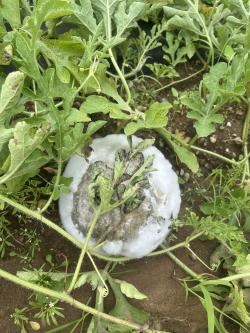
 Phytophthora blight is continuing to develop, both in cucurbit and pepper crops. Fruit rots caused by Phytophthora blight will start on the side of the fruit that is in contact with the soil. The lesion will develop a wet, powdery sporulation that looks similar to powdered sugar. This is in comparison to Pythium rot, which is a much less aggressive disease but will also cause fruit rot in cucurbits. Pythium forms fluffy white mycelium (fungal growth) on infected fruit.
Phytophthora blight is continuing to develop, both in cucurbit and pepper crops. Fruit rots caused by Phytophthora blight will start on the side of the fruit that is in contact with the soil. The lesion will develop a wet, powdery sporulation that looks similar to powdered sugar. This is in comparison to Pythium rot, which is a much less aggressive disease but will also cause fruit rot in cucurbits. Pythium forms fluffy white mycelium (fungal growth) on infected fruit.
Squash vine borer numbers are continuing to drop and most trapping sites are below threshold for spraying in all cucurbit crops. There may be a second generation of adults that emerge in mid-August, and we will continue to monitor for that. The larvae from that generation often bore into winter squash fruit.
|
table 1. Squash Vine borer Pheromone Trap captures for week ending July 24
|
|
|---|---|
|
Trap location
|
SVB
|
|
Whately
|
0 |
|
Leominster
|
0 |
|
Sharon
|
10 |
|
Westhampton
|
2 |
|
Spray thresholds: Thick-stemmed cucurbits only. 5 moths/week for bush-type cucurbits. 12 moths/week for vining cucurbits.
|
|
Nightshades
Colorado potato beetle adults are laying eggs now. Be sure to use a different IRAC class on this generation than you did on the first. Labeled conventional products include pyrethroids (IRAC Group 3A), neonicotinoids (Group 4A), novaluron (e.g. Rimon, Group 15), cyromazine (e.g. Trigard, Group 17), and diamides (e.g. Verimark, Exirel, Group 28). In recent years, we have observed resistance to both neonicotinoids (e.g. Assail, Belay, Venom, Actara, Cruiser, Platinum) and synthetic spinosads (e.g. Radiant) in New England.
 Pepper maggot flies are continuing to lay eggs in pepper fields. Growers are often not aware of pepper maggot infestations because infested peppers become rotten and are culled in the field during harvest or in the pack house. Cut open rotten peppers or peppers that fill with water during washing and examine for 1 cm-long maggots feeding inside. For information on management, see last week’s article.
Pepper maggot flies are continuing to lay eggs in pepper fields. Growers are often not aware of pepper maggot infestations because infested peppers become rotten and are culled in the field during harvest or in the pack house. Cut open rotten peppers or peppers that fill with water during washing and examine for 1 cm-long maggots feeding inside. For information on management, see last week’s article.
Sweet corn
European corn borer (ECB) trap counts are higher than last week, as expected with the start of the 2nd flight. Caterpillars will bore through the whorl to feed in the developing tassel before moving down into the ear when the tassel emerges. If corn earworm trap counts do not warrant a spray, scout block for ECB and FAW and spray if 12% of plants are infested with either.
Corn earworm trap counts are also up, with a whopping high of 206 caught this week at one site in Norfolk Co. (Table 2). Most locations are on a 4-day spray schedule. Don’t forget to shorten the spray schedule by 1 day if you have 2+ consecutive days above 80°F. Do not rely solely on pyrethroids for CEW management. Bt varieties that contain the vip3A gene (e.g. Attribute II, Attribute Plus) will control CEW—this pest is resistant to the other Bt genes.
Fall armyworm (FAW) moths are being caught at 5 out of 15 trapping sites this week, up from 3 sites last week. Check whorl-stage corn for ragged feeding injury and lots of sawdust-like frass characteristic of FAW.
See the article in this issue for information on identifying which of these caterpillars is/are present in your corn crops.
| Table 2. GDDs & Sweet corn pest trap captures for week ending July 24 | |||||||
|---|---|---|---|---|---|---|---|
| Nearest Weather station |
GDD (Base 50°F) |
Trap Location | ECB NY | ECB IA | FAW | CEW | CEW SPRay interval* |
| Western MA | |||||||
| North Adams | 1563 | n/a | |||||
| Richmond | 1401 | n/a | |||||
| South Deerfield | 1680 | Whately | 11 | 0 | 0 | 14.5 | 4 days |
| Easthampton | 1612 | Northampton | n/a | n/a | n/a | 8.5*** | 4 days |
| Chicopee Falls | 1723 | Granby | 0 | 0 | 0 | 1 | no spray** |
| Granville | 1472 | Southwick | 1 | 0 | 2 | 9 | 4 days |
| Central MA | |||||||
| Leominster | 1550 | Leominster | 9 | 0 | 0 | 27 | 4 days |
| Lancaster | 6 | 0 | 0 | 5 | 5 days | ||
| Northbridge | 1567 | Grafton | 0 | 0 | 1 | 8 | 4 days |
| Worcester | 1564 | Spencer | 1 | 0 | 0 | 5 | 5 days |
| Eastern MA | |||||||
| Bolton | 1573 | Bolton | 1 | 1 | 3 | 20 | 4 days |
| Stow | 1591 | Concord | 0 | 0 | 0 | 4 | 5 days |
| Lawrence | 1606 | Haverhill | 0 | 0 | 2 | 0 | no spray** |
| Ipswich | 1569 | Ipswich | 0 | 0 | 0 | 14 | 4 days |
| Harvard | 1566 | Littleton | 6 | 0 | 0 | 9 | 4 days |
| - | - | Millis | 1 | 6 | n/a | 22 | 4 days |
| Sharon | 1538 | North Easton | 0 | 0 | 0 | 23 | 4 days |
| Sharon | 0 | 0 | n/a | 206 | 3 days | ||
| - | - | Sherborn | 0 | 0 | 0 | 5 | 5 days |
| Providence, RI | 1589 | Seekonk | 0 | 0 | 16 | 42 | 4 days |
| Swansea | 5 | 0 | 0 | 6 | 5 days | ||
|
ND - no GDD data for this location - no numbers reported for this trap n/a - this site does not trap for this pest * If 2+ days above 80°F occur, shorten spray interval by 1 day. ** If CEW trap captures are below 1.4 moths/week, scout block for ECB and FAW caterpillars and make a pesticide application if 12% of plants in a 50-plant sample are infested. *** Count is for four days only |
|||||||
| Table 3. corn earworm spray intervals | ||
|---|---|---|
| Moths/Night | Moths/Week | Spray Interval |
| 0 - 0.2 | 0 - 1.4 | no spray |
| 0.2 - 0.5 | 1.4 - 3.5 | 6 days |
| 0.5 - 1 | 3.5 - 7 | 5 days |
| 1 - 13 | 7 - 91 | 4 days |
| Over 13 | Over 91 | 3 days |
Cut Flower Pest Alerts
Dahlias

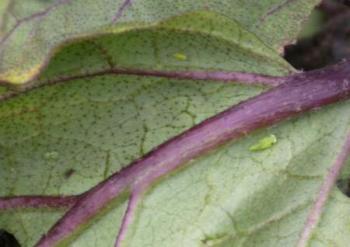 Potato leafhopper (PLH, Empoasca fabae) populations and hopperburn are increasing in dahlias. PLH are a frequent pest of dahlias. Adults are approximately 1/8 inch long, yellowish-green and wedge-shaped. Adults move quickly when disturbed; when the host crop is brushed or jostled, they often fly up from the foliage, looking like tiny sparks. Nymphs are usually on the undersides of leaves and characteristically walk sideways when disturbed. They overwinter in the Gulf Coast states and move north every spring, affecting many vegetable and ornamental species. Adults and nymphs inject a toxin as they feed, which disrupts plant conductive tissue and causes leaves to turn yellow-ish brown at the edges, a condition known as "hopperburn". The most effective OMRI-listed materials are pyrethrins (e.g. PyGanic) and azadirachtin (many trade names).
Potato leafhopper (PLH, Empoasca fabae) populations and hopperburn are increasing in dahlias. PLH are a frequent pest of dahlias. Adults are approximately 1/8 inch long, yellowish-green and wedge-shaped. Adults move quickly when disturbed; when the host crop is brushed or jostled, they often fly up from the foliage, looking like tiny sparks. Nymphs are usually on the undersides of leaves and characteristically walk sideways when disturbed. They overwinter in the Gulf Coast states and move north every spring, affecting many vegetable and ornamental species. Adults and nymphs inject a toxin as they feed, which disrupts plant conductive tissue and causes leaves to turn yellow-ish brown at the edges, a condition known as "hopperburn". The most effective OMRI-listed materials are pyrethrins (e.g. PyGanic) and azadirachtin (many trade names).
Bacterial soft rot (Erwinia or Pectobacterium) was identified in dahlias in Hampshire Co., though the soft rot was determined to a secondary infection after tubers were damaged by unidentified insect feeding. Soft-rot bacteria thrive in warm temperatures and wet conditions. Infected stems were brown and soft. They are spread easily by water splash, infected tools, insects, irrigation and cultivation. These bacteria infect plant tissue through wounds made by human activity, insects, machinery, low temperatures, windblown soil, hail, or other diseases. Dahlias and other hollow-stemmed flowers are especially vulnerable as rainwater may collect in cut stems. To manage soft rot, control insect pests. Other practices that can help manage bacterial soft rot include: eliminating cull piles from production fields, rotating with non-susceptible crops, planting on well-drained soil or in raised plant beds, and reducing plant density to reduce leaf wetness. Harvest plants only when dry and avoid wounding during harvest, packing, and transporting. Frequent disinfestation of tools and hands can reduce disease spread. There are no effective pesticide or biological control options.
Zinnias
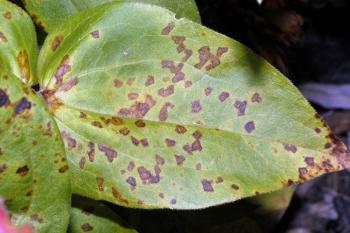 Bacterial leaf spot (Xanthomonas campestris) was detected in zinnias in Hampshire Co. this week. This disease is a common and widespread problem in both greenhouse production and in fields and gardens. Disease development is favored by warm, wet, and humid conditions, and the disease is transmitted via infected seeds or plant materials. These bacteria can survive in dried leaves for as long as a year and can reside on foliage for several months before initiating disease. Bactericides are only marginally effective in managing bacterial diseases, so sanitation and environmental control are extremely important. Minimize splashing and reduce leaf wetness by increasing spacing and/or improving air circulation with fans where applicable, and irrigating using drip irrigation instead of overhead where possible. Avoid handling wet foliage. Remove diseased plant debris and affected plants from the growing area. Workers should wash their hands after handling diseased plants or soil. Plant resistant varieties whenever possible. The zinnia series 'Crystal' and 'Star' are highly resistant to bacterial leaf spot; 'Profusion' is moderately resistant. Copper products (Champion, Nu-Cop 3, Camelot, Phyton) are registered for the control of Xanthomonas species.
Bacterial leaf spot (Xanthomonas campestris) was detected in zinnias in Hampshire Co. this week. This disease is a common and widespread problem in both greenhouse production and in fields and gardens. Disease development is favored by warm, wet, and humid conditions, and the disease is transmitted via infected seeds or plant materials. These bacteria can survive in dried leaves for as long as a year and can reside on foliage for several months before initiating disease. Bactericides are only marginally effective in managing bacterial diseases, so sanitation and environmental control are extremely important. Minimize splashing and reduce leaf wetness by increasing spacing and/or improving air circulation with fans where applicable, and irrigating using drip irrigation instead of overhead where possible. Avoid handling wet foliage. Remove diseased plant debris and affected plants from the growing area. Workers should wash their hands after handling diseased plants or soil. Plant resistant varieties whenever possible. The zinnia series 'Crystal' and 'Star' are highly resistant to bacterial leaf spot; 'Profusion' is moderately resistant. Copper products (Champion, Nu-Cop 3, Camelot, Phyton) are registered for the control of Xanthomonas species.
--Written by Angie Madeiras and Hannah Whitehead
Contact Us
Contact the UMass Extension Vegetable Program with your farm-related questions, any time of the year. We always do our best to respond to all inquiries.
Vegetable Program: 413-577-3976, umassveg@umass.edu
Staff Directory: https://ag.umass.edu/vegetable/faculty-staff
Home Gardeners: Please contact the UMass GreenInfo Help Line with home gardening and homesteading questions, at greeninfo@umext.umass.edu.
Identifying Caterpillars in Sweet Corn
We are at the point in the season when all the major caterpillar pests of corn are present in corn fields—European corn borer (ECB), corn earworm (CEW), and fall armyworm (FAW).
If you are noticing unacceptable amounts of caterpillar damage in your sweet corn now, take the time to identify which corn pests are present. The most effective and efficient management strategy involves attracting and trapping moths using pheromones and using trap counts for each moth to inform spraying and/or scouting schedules. Earlier in the season, when ECB is the only caterpillar pest present, ECB trap captures tell us when the moth flight is beginning and therefore when to scout for caterpillars in the emerging tassels and early silks. ECB scouting results then tell growers if they are under or over a predetermined spray threshold. Once CEW arrives, the CEW trap captures determine the spray schedule: more moths caught per week mean fewer days between sprays. For more information on managing all 3 corn caterpillar pests, see the following articles in past Vegetable Notes issues:
- Corn Earworm Management
*Our newsletter archive is undergoing updates. If this link doesn’t work and you’d like to access this article, please email us at umassveg@umass.edu. - Pheromone Trapping for Sweet Corn Caterpillar Pests
European Corn Borer
European corn borer is the first corn caterpillar pest to show up in sweet corn, as they overwinter in crop residues throughout the Northeast. ECB moths begin emerging in May (at 375 GDD base 50°F), mate, and lay eggs, which will hatch in 4 to 9 days, depending on the temperature. The newly hatched larvae will move to the closest protected feeding spot—whorl, tassel, ear—and will feed for 5 to 7 days before boring into the corn stem or ear. First generation larvae will pupate and emerge as adults at 1400 GDD (usually mid- to late-July) to mate and lay eggs. The second generation will overwinter as pupae, protected inside corn stems in the field. Historically, there have been 2 strains of ECB common in the Northeast: the New York strain (ECB-NY), and the Iowa strain (ECB-IA). ECB-NY usually arrives in New England before ECB-IA, and in greater numbers. In recent years, growers trapping for ECB have seen significant caterpillar damage in the field despite very low trap captures. NY and NH Extensions have deployed a hybrid ECB-NY/-IA lure to determine if this feeding damage is being caused by a hybrid of the two strains, but that does not seem to be the case and the low trap captures remain a mystery.
Adults are ¾ inch long moths, white to tan, with 2 dark, serrated lines running across the lower part of the forewings.
Eggs are laid in clusters on undersides of leaves—they are flat and overlap each other like fish scales. They are white when freshly laid, becoming cream-colored then orange-tan as they mature. Before hatching, the black head capsules of the enclosed larvae are visible.
Caterpillars vary in color from light-gray to pink but always have small, dark spots on each body segment. They have brown head capsules, and light red-brown stripes running the length of their bodies. Mature larvae are ¾ to 1 inch long.
Where might you see ECB? Before there is silk, caterpillars bore into the tassel or stalk. The weakened stalk will often flop over and you will see flagging tops in the field. Once there is silk in the field, ECB will enter the ears through the silk channel, or bore directly into the side of the ear. You may often see them in ripening corn boring into the side of the ear next to the corn stalk.
Corn Earworm
Corn earworm historically did not overwinter in New England and was instead blown in on storms coming from the South or from western New York where they overwinter, arriving in mid-July. In recent years, CEW is showing up earlier in the season, indicating the presence of overwintering populations of CEW in our region. Moths from overwintered CEW that are caught in pheromone traps will look “clean” and new, compared to moths that are blown up from the South which often look beat up and disheveled from their long journey. Eggs are small translucent globes laid in silks and are difficult to find. Eggs hatch in 2.5 to 6 days, and newly hatched larvae enter the ear through the silk channel and feed for 3 to 4 weeks before pupating. Although each female lays several eggs on each ear, you will only find one caterpillar per ear, as the small caterpillars are cannibalistic. Moths are blown in throughout the growing season, so spikes in trap captures followed by increased caterpillar damage are sometimes linked to storms. Additionally, a 2nd generation of moths can emerge to mate and lay eggs, adding to the constant presence of this pest throughout the summer.
Adults are yellow-brown moths with a red "humpback", a dark spot in the middle of each wing, and a dark band across the bottom of each wing. They can be easily confused with the spongy moth (Lymantria dispar) but have relatively thin antennae compared to the spongy moth's thick, feathery antennae. Live or newly dead moths have light green eyes.
Eggs are tiny, white, and round. In the silk, they look like dew drops and are very hard to see.
Caterpillars vary in color, similarly to ECB, from green to pink to brown to nearly black. Alternating light and dark stripes run the length of their bodies, and they have sparse hairs covering their bodies. Each body segment has a group of 3 small dots on the side. The head capsules are always plain golden brown (compared to the head capsules of FAW, which have a Y pattern—see photo below).
Where would you be seeing CEW now? CEW are in ear tips—look for messy frass and/or chewed up silks.
Fall Armyworm
Fall armyworm does not overwinter in the Northeast; moths are blown northward on storm fronts, usually starting in mid-July. CEW is also blown in on storms, though they don’t always move together. Females prefer laying their eggs in whorl-stage corn. Eggs are laid on leaves and hatch in ~5 days. The larvae feed in the whorl and newly forming tassel, creating large, ragged holes in the leaves and dropping big clumps of frass. Larvae feed for 15 to 20 days.
Adults are ¾-inch long, mottled dark gray moths, with some light spots on their wings and an obvious white area at the extreme tips of their wings.
Eggs are laid in masses on leaves and are surrounded by fuzzy hairs from the female moth.
Caterpillars are light-tan to dark black, with some longitudinal striping along their bodies. Their bodies are smooth, unlike the hairy CEW caterpillars. When viewed head on, FAW head capsules are divided by an inverted “Y”, compared to the solid CEW head capsule.
Where would you be seeing FAW now? Check whorl-stage corn for large, ragged holes in the foliage, and big clumps of frass in the whorl. Often, the FA W caterpillar will be within the developing tassel. FAW will also bore into the sides of ears, similarly to ECB, and can also infest ear tips.
--Written by Genevieve Higgins, UMass Extension
Identifying Potato Tuber Diseases
Potatoes are going down early this season, some from disease, some from insect pests. With yellowing foliage or lots of feeding damage, we expect potato harvest to begin earlier than normal this year. There are many diseases that affect potato tubers, so ahead of your potato harvest this year, take a moment to familiarize yourself with the range of symptoms. Proper identification will help you decide which tubers will store well and which should be sold as tablestock, and will give you a better idea of which soil-borne diseases are present in your fields, improving your future crop rotations. To be sure of a diagnosis, samples can be submitted to the UMass Plant Diagnostic Lab. Most of thee diseases (except for scabs, scurfs, and potato virus Y) get started on foliage and, if controlled there, can be prevented on tubers. See the New England Vegetable Management potato disease section for fungicide recommendations.
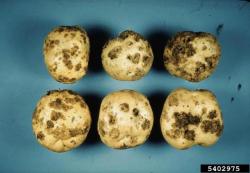 Common scab (Bacterial: Streptomyces spp.) produces tan to dark brown, circular or irregular lesions, which are rough in texture. Scab may be superficial (russet scab), slightly raised (erumpent scab), or sunken (pitted scab). The type of lesion is dependent on potato cultivar, tuber maturity at infection, organic matter content of soil, strain of the pathogen, and the environment. Common scab is controlled or greatly suppressed at soil pH levels of 5.2 or lower, though a closely related but less common species of Streptomyces known as acid scab can survive down to 4.0.
Common scab (Bacterial: Streptomyces spp.) produces tan to dark brown, circular or irregular lesions, which are rough in texture. Scab may be superficial (russet scab), slightly raised (erumpent scab), or sunken (pitted scab). The type of lesion is dependent on potato cultivar, tuber maturity at infection, organic matter content of soil, strain of the pathogen, and the environment. Common scab is controlled or greatly suppressed at soil pH levels of 5.2 or lower, though a closely related but less common species of Streptomyces known as acid scab can survive down to 4.0.
Maintaining moist soil conditions, especially during tuber initiation, can be an effective way to prevent scab infections, though is usually tricky to implement on the scale most potatoes are grown. However, in a wetter year like this one, perhaps scab is one disease we might see less of!
Some varieties are more susceptible to scab than others, with red skinned varieties generally being most sensitive and russets being most resistant. From Christopher Clark, USDA-ARS Vegetable Breeder, “Some recently released cultivars that are at least partially common scab resistant are Lamoka, Upstate Abundance, and Caribou, though none of these are highly scab resistant. In our very limited trials, Blazer, Canela, and Gold Rush Russet potatoes performed better for common scab resistance than some of the more commonly grown russets when challenged with the species of the pathogen that appears to be the most prevalent in New England. For red potatoes, Dark Red Norland performed the best for scab resistance in some of our limited trials among red potatoes, though it is still quite susceptible. Superior is a white potato that performs reasonably well for scab resistance.”
For conventional growers, the fungicide quintozene (Blocker) seems to work quite well.
 Early blight (Fungal: Alternaria solani) usually affects potato foliage but tuber infections can also occur. Tuber lesions are dark, sunken, and circular, and are often bordered by raised, purple to gray tissue. The underlying flesh is dry, leathery, and brown. Lesions can increase in size during storage, causing tubers to become shriveled.
Early blight (Fungal: Alternaria solani) usually affects potato foliage but tuber infections can also occur. Tuber lesions are dark, sunken, and circular, and are often bordered by raised, purple to gray tissue. The underlying flesh is dry, leathery, and brown. Lesions can increase in size during storage, causing tubers to become shriveled.
 Fusarium dry rot (Fungal: Fusarium spp.) causes internal, light to dark brown or black dry rot of the potato tuber. The rot may develop at an injury site, such as a bruise or cut. The pathogen penetrates the tuber, often rotting out the center. Extensive rotting causes the tissue to shrink and collapse, usually leaving a dark sunken area on the outside of the tuber and internal cavities.
Fusarium dry rot (Fungal: Fusarium spp.) causes internal, light to dark brown or black dry rot of the potato tuber. The rot may develop at an injury site, such as a bruise or cut. The pathogen penetrates the tuber, often rotting out the center. Extensive rotting causes the tissue to shrink and collapse, usually leaving a dark sunken area on the outside of the tuber and internal cavities.
 Silver scurf (Fungal: Helminthosporium solani) affects only tuber periderm (skin). Lesions start at the stolon end of the tuber as small, pale brown spots which may be difficult to detect at harvest but will continue to develop in storage. In storage, lesions may darken and the skin may slough off. Many small circular lesions may coalesce to form large affected areas. Tubers may also dry out and become wrinkled due to excessive moisture loss in storage.
Silver scurf (Fungal: Helminthosporium solani) affects only tuber periderm (skin). Lesions start at the stolon end of the tuber as small, pale brown spots which may be difficult to detect at harvest but will continue to develop in storage. In storage, lesions may darken and the skin may slough off. Many small circular lesions may coalesce to form large affected areas. Tubers may also dry out and become wrinkled due to excessive moisture loss in storage.

 Black dot (Fungal: Colletotrichum coccodes): On potato foliage, symptoms of black dot are nearly indistinguishable from early blight. On tubers, it produces large discolored areas that can easily be mistaken for silver scurf. Under a 10X lens, tiny black sclerotia are visible on the surface of the affected tissue.
Black dot (Fungal: Colletotrichum coccodes): On potato foliage, symptoms of black dot are nearly indistinguishable from early blight. On tubers, it produces large discolored areas that can easily be mistaken for silver scurf. Under a 10X lens, tiny black sclerotia are visible on the surface of the affected tissue.

 Black scurf and Rhizoctonia canker (Fungal: Rhizoctonia solani): Black scurf is purely cosmetic and does not reduce yield, even in storage. Irregular, hard, black masses that develop on tuber surfaces are overwintering structures (sclerotia) of the fungus. Development of these sclerotia may be minimized by harvesting tubers soon after vine-kill and skin set. While the sclerotia themselves do not cause damage, they allow the pathogen to survive in the soil and serve as evidence of its presence. In cool, wet soils, R. solani can cause dark, sunken lesions on underground sprouts and stolons. These lesions can cut off the supply of nutrients and kill tubers, or can reduce the transfer of starches to the tubers, reducing their size. Cankers can also form on the tubers themselves, usually at the stolon or in lenticels. Tuber cankers vary greatly in size, from small and superficial to large, sunken, and necrotic.
Black scurf and Rhizoctonia canker (Fungal: Rhizoctonia solani): Black scurf is purely cosmetic and does not reduce yield, even in storage. Irregular, hard, black masses that develop on tuber surfaces are overwintering structures (sclerotia) of the fungus. Development of these sclerotia may be minimized by harvesting tubers soon after vine-kill and skin set. While the sclerotia themselves do not cause damage, they allow the pathogen to survive in the soil and serve as evidence of its presence. In cool, wet soils, R. solani can cause dark, sunken lesions on underground sprouts and stolons. These lesions can cut off the supply of nutrients and kill tubers, or can reduce the transfer of starches to the tubers, reducing their size. Cankers can also form on the tubers themselves, usually at the stolon or in lenticels. Tuber cankers vary greatly in size, from small and superficial to large, sunken, and necrotic.
 Pink rot (Oomycete: Phytophthora erythroseptica): Pink rot infections start at the stolon end of tubers and result in rotten and discolored periderm with a clear delineation between healthy and diseased tissue. When exposed to air, tuber flesh turns pink and then brown-black.
Pink rot (Oomycete: Phytophthora erythroseptica): Pink rot infections start at the stolon end of tubers and result in rotten and discolored periderm with a clear delineation between healthy and diseased tissue. When exposed to air, tuber flesh turns pink and then brown-black.
 Pythium leak (Oomycete: Pythium spp.): The Pythium species that cause leak infections invade tubers through harvest wounds and continue to develop in transit and storage. Infections result in internal watery, gray or brown rot with well-defined red-brown lines delineating healthy and diseased tissue.
Pythium leak (Oomycete: Pythium spp.): The Pythium species that cause leak infections invade tubers through harvest wounds and continue to develop in transit and storage. Infections result in internal watery, gray or brown rot with well-defined red-brown lines delineating healthy and diseased tissue.
 Late blight (Oomycete: Phytophthora infestans) affects potato foliage and tubers. Foliar symptoms start with brown to black, water-soaked lesions on leaves and stems, which produce visible white sporulation at the lesion margins under humid conditions. Whole plants and fields may collapse rapidly. Tuber infection is initiated by sporangia from foliage being washed down into the soil and usually begins in wounds, eyes, or lenticels. Lesions are copper brown, red or purplish and white sporulation may occur on tuber surfaces in storage or cull piles. Infected tubers are susceptible to infection by soft rot bacteria, which can turn entire bins of potatoes in storage into a smelly, rotten mass. (Late blight has not been seen in MA since 2017; there is currently a report in central NY and a few reports in southern Ontario.)
Late blight (Oomycete: Phytophthora infestans) affects potato foliage and tubers. Foliar symptoms start with brown to black, water-soaked lesions on leaves and stems, which produce visible white sporulation at the lesion margins under humid conditions. Whole plants and fields may collapse rapidly. Tuber infection is initiated by sporangia from foliage being washed down into the soil and usually begins in wounds, eyes, or lenticels. Lesions are copper brown, red or purplish and white sporulation may occur on tuber surfaces in storage or cull piles. Infected tubers are susceptible to infection by soft rot bacteria, which can turn entire bins of potatoes in storage into a smelly, rotten mass. (Late blight has not been seen in MA since 2017; there is currently a report in central NY and a few reports in southern Ontario.)
 Potato virus Y can cause necrotic ringspots on tubers, depending on which strain of the virus is present, which potato variety is grown, and the time of infection. Affected tubers have roughened rings of darker brown or reddened skin. Necrosis beneath the rings may extend into the tuber flesh. Necrotic symptoms in tubers often increase after storage. Potato varieties vary in their susceptibility to PVY and the symptoms they exhibit on foliage and on tubers; Yukon Gold is particularly susceptible to tuber necrosis. Management of this disease starts with sourcing certified disease-free seed tubers, then preventing spread by aphids by planting buffers around the potato crop.
Potato virus Y can cause necrotic ringspots on tubers, depending on which strain of the virus is present, which potato variety is grown, and the time of infection. Affected tubers have roughened rings of darker brown or reddened skin. Necrosis beneath the rings may extend into the tuber flesh. Necrotic symptoms in tubers often increase after storage. Potato varieties vary in their susceptibility to PVY and the symptoms they exhibit on foliage and on tubers; Yukon Gold is particularly susceptible to tuber necrosis. Management of this disease starts with sourcing certified disease-free seed tubers, then preventing spread by aphids by planting buffers around the potato crop.
Physiological Disorders
 Black heart is caused by lack of oxygen during storage, which causes the tissue to die from the inside out and turn black. The condition is not reversible, but if you notice it quickly and correct your storage conditions you can prevent the whole crop from being affected.
Black heart is caused by lack of oxygen during storage, which causes the tissue to die from the inside out and turn black. The condition is not reversible, but if you notice it quickly and correct your storage conditions you can prevent the whole crop from being affected.
 Brown center and hollow heart are internal physiological disorders of potato that often occur together. Brown center is an area of dead pith cells that turn brown, while hollow heart is a star- or lens-shaped hollow area in the center of the tuber. These disorders make fresh-market tubers unattractive and can reduce repeat sales. Severe hollow heart negatively impacts the quality of chip-processing potatoes and can result in shipments not making grade. Both disorders are related to stress, and occur at a higher incidence when growing conditions abruptly change during the season. Brown center and hollow heart likely form during tuber initiation but could also form during tuber bulking. If the disorder occurs during the early part of the season, it most often begins as brown center that forms in the stem-end of the tuber, while late-forming hollow heart usually occurs near the bud-end with no brown center symptoms. Conditions such as soil temperatures below 56°F for 5-8 days, or available soil moisture above 80% initiate brown center formation. Incidence of brown center and hollow heart also increases with periods of stress caused by high or low soil moisture, especially if heavy rains occur suddenly after a dry spell. Large tubers are more prone to develop the disorder, so using closer spacing and avoiding skips in the row can reduce incidence of brown center and hollow heart. There are also differences in the susceptibility of potato varieties to both of these disorders.
Brown center and hollow heart are internal physiological disorders of potato that often occur together. Brown center is an area of dead pith cells that turn brown, while hollow heart is a star- or lens-shaped hollow area in the center of the tuber. These disorders make fresh-market tubers unattractive and can reduce repeat sales. Severe hollow heart negatively impacts the quality of chip-processing potatoes and can result in shipments not making grade. Both disorders are related to stress, and occur at a higher incidence when growing conditions abruptly change during the season. Brown center and hollow heart likely form during tuber initiation but could also form during tuber bulking. If the disorder occurs during the early part of the season, it most often begins as brown center that forms in the stem-end of the tuber, while late-forming hollow heart usually occurs near the bud-end with no brown center symptoms. Conditions such as soil temperatures below 56°F for 5-8 days, or available soil moisture above 80% initiate brown center formation. Incidence of brown center and hollow heart also increases with periods of stress caused by high or low soil moisture, especially if heavy rains occur suddenly after a dry spell. Large tubers are more prone to develop the disorder, so using closer spacing and avoiding skips in the row can reduce incidence of brown center and hollow heart. There are also differences in the susceptibility of potato varieties to both of these disorders.
--Written by Susan B. Scheufele
Abiotic Disorders of Tomato diseases
Field tomato season has begun, and high tunnel tomato harvest is already well underway. Now is the time to make sure you’re providing tomatoes with sufficient nutrients and consistent water to avoid some of the disorders described in this article. All of the disorders described in this article are abiotic, meaning they are not caused by living pathogens but instead by environmental factors. In many cases, the answer to avoiding these disorders is proper fertility and consistent irrigation.
Blossom End Rot
 Blossom end rot is characterized by dark brown or black sunken areas at the blossom end of the fruit. The lesions are a direct result of a localized calcium deficiency at the blossom end. The dead tissue is initially brown or white and leathery but often becomes colonized by the saprophytic fungus Alternaria alternata, which only infects dead tissue and produces fuzzy black sporulation. Although calcium deficiencies in the soil are sometimes responsible for blossom end rot, much of the time, blossom end rot is the result of plant water stress. When temperatures increase, so does water demand, and developing fruits have high calcium demand. Calcium is taken up primarily through the water-conducting tissues of the plant, so when the soil is dry, or overly saturated, or the plant’s roots are compromised and the plant isn’t taking up water, calcium deficiencies develop. The blossom end of the fruit is the last to accumulate calcium, so this is where deficiencies appear. Signs of blossom end rot typically appear two weeks after the deficiency in the plant has occurred.
Blossom end rot is characterized by dark brown or black sunken areas at the blossom end of the fruit. The lesions are a direct result of a localized calcium deficiency at the blossom end. The dead tissue is initially brown or white and leathery but often becomes colonized by the saprophytic fungus Alternaria alternata, which only infects dead tissue and produces fuzzy black sporulation. Although calcium deficiencies in the soil are sometimes responsible for blossom end rot, much of the time, blossom end rot is the result of plant water stress. When temperatures increase, so does water demand, and developing fruits have high calcium demand. Calcium is taken up primarily through the water-conducting tissues of the plant, so when the soil is dry, or overly saturated, or the plant’s roots are compromised and the plant isn’t taking up water, calcium deficiencies develop. The blossom end of the fruit is the last to accumulate calcium, so this is where deficiencies appear. Signs of blossom end rot typically appear two weeks after the deficiency in the plant has occurred.
Blossom end rot can be prevented by regular watering to avoid extreme fluctuations in soil moisture. In high tunnel tomatoes, it is recommended to use more than one drip line per bed to ensure that the entire extensive root system is able to supply sufficient water to the lush foliage. Be careful to avoid overwatering, though, as this can lead to root rots or other physiological disorders. Use of soil moisture monitors can help dial in watering needs. High soluble salts, low calcium, and high cation (potassium, magnesium or ammonium) levels in the soil may also contribute to blossom end rot; other cations may out-compete calcium on soil exchange sites, making it unavailable to the plant.
Management: Plant into sites with good soil drainage. Use plastic or other mulch to maintain soil moisture. Avoid aggressive cultivation that damages crop roots. Maintain sufficient, even soil moisture. Use soil nutrient testing to monitor soil soluble salts and cation ratios and maintain adequate calcium in the soil.
Leaf Roll
 Leaf roll is usually a reaction by the plant to conserve water by reducing the surface area exposed to solar radiation. This disorder is often seen just after plants are heavily pruned under dry soil conditions, but oddly enough, leaf roll disorder also has been found to be caused by excess soil moisture coupled with extended high temperatures. If the tomato plant’s foliar growth is more vigorous than root growth and we are hit with a hot, dry period, the foliage may transpire water faster than the root system can absorb it from the soil, and the plant’s reaction is to roll it’s leaves up to reduce transpiration. This disorder primarily affects lower leaves. Leaf rolling can also result from growing high-yielding cultivars under high-nitrogen fertility programs. Cultivars selected for high yield or early ripening tend to be the most susceptible and indeterminate cultivars are more sensitive than determinate. The good news is that leaf roll rarely affects plant growth, fruit yield, or fruit quality. Some viruses can look similar to tomato leaf roll, but if the symptoms appear suddenly, involve many of the plants in a field, and largely affects lower leaves, it is probably just physiological leaf roll.
Leaf roll is usually a reaction by the plant to conserve water by reducing the surface area exposed to solar radiation. This disorder is often seen just after plants are heavily pruned under dry soil conditions, but oddly enough, leaf roll disorder also has been found to be caused by excess soil moisture coupled with extended high temperatures. If the tomato plant’s foliar growth is more vigorous than root growth and we are hit with a hot, dry period, the foliage may transpire water faster than the root system can absorb it from the soil, and the plant’s reaction is to roll it’s leaves up to reduce transpiration. This disorder primarily affects lower leaves. Leaf rolling can also result from growing high-yielding cultivars under high-nitrogen fertility programs. Cultivars selected for high yield or early ripening tend to be the most susceptible and indeterminate cultivars are more sensitive than determinate. The good news is that leaf roll rarely affects plant growth, fruit yield, or fruit quality. Some viruses can look similar to tomato leaf roll, but if the symptoms appear suddenly, involve many of the plants in a field, and largely affects lower leaves, it is probably just physiological leaf roll.
Management: Reduce symptoms by maintaining consistent, adequate soil moisture (~1 inch per week during the growing season, which will also help with calcium uptake, reducing blossom end rot incidence). Do not prune heavily during hot, dry conditions or over-fertilize with nitrogen.
Catfacing
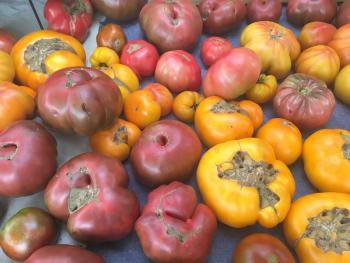 Tomatoes are considered “catfaced” if the blossom scar is enlarged or perforated. This can happen to both field and greenhouse tomatoes and is more common in heirloom cultivars and varieties with rounder and larger fruit. Often, the fruit becomes extremely misshapen, but fruit distortion is not necessary to classify it as catfaced. This disorder has not been extensively researched and is still not fully understood. Cold temperatures during flowering have been shown to increase incidence of catfacing, as have extreme fluctuations in night versus day temperatures. Damage from thrips to the side of the pistil of tomato flowers can also cause this disorder, and under some conditions, pruning and high nitrogen levels can increase catfacing incidence. Catfacing can increase the chances of fruit becoming infected via the rough blossom scar by black mold rot, a disease caused by several different fungi.
Tomatoes are considered “catfaced” if the blossom scar is enlarged or perforated. This can happen to both field and greenhouse tomatoes and is more common in heirloom cultivars and varieties with rounder and larger fruit. Often, the fruit becomes extremely misshapen, but fruit distortion is not necessary to classify it as catfaced. This disorder has not been extensively researched and is still not fully understood. Cold temperatures during flowering have been shown to increase incidence of catfacing, as have extreme fluctuations in night versus day temperatures. Damage from thrips to the side of the pistil of tomato flowers can also cause this disorder, and under some conditions, pruning and high nitrogen levels can increase catfacing incidence. Catfacing can increase the chances of fruit becoming infected via the rough blossom scar by black mold rot, a disease caused by several different fungi.
Management: Avoid excessive pruning and nitrogen fertilization. Avoid low greenhouse temperatures for both greenhouse tomatoes and transplants. Use cultivars that are less prone to catfacing. Remove catfaced fruit so they don’t drain plant nutrients.
Stitching/Zippering
 Stitching or zippering are terms for when a thin, brown, necrotic scar extends from the stem to the blossom end on fruit. The longitudinal scar has small transverse scars along it, making it resemble a zipper or seam. Fruit can have one or several scars. This disorder is purely cosmetic and does not affect the edibility of the fruit but may render fruit unmarketable. Zippering is caused by anthers (the pollen-producing flower part) fused to the ovary wall of newly forming fruit. This disorder occurs more frequently in cool weather.
Stitching or zippering are terms for when a thin, brown, necrotic scar extends from the stem to the blossom end on fruit. The longitudinal scar has small transverse scars along it, making it resemble a zipper or seam. Fruit can have one or several scars. This disorder is purely cosmetic and does not affect the edibility of the fruit but may render fruit unmarketable. Zippering is caused by anthers (the pollen-producing flower part) fused to the ovary wall of newly forming fruit. This disorder occurs more frequently in cool weather.
Management: Plant cultivars that are less susceptible to stitching/zippering. Avoid low greenhouse temperatures.
Fruit Cracking
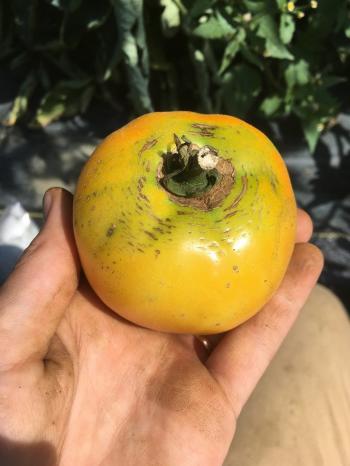

 Fruit cracking can occur in several different patterns – radial cracks starting at the stem scar, concentric cracks circling the fruit shoulders, small cracks around the shoulders called “rain checking”. These cracks are caused by excessive water uptake by the plant during fruit development, when interior tissues expand faster than the inflexible skin. High temperatures can make fruits more susceptible to cracking, and cultivars with large fruit tend to be more susceptible. Opportunistic fungi and bacteria can enter the fruit through cracks and cause fruit rots.
Fruit cracking can occur in several different patterns – radial cracks starting at the stem scar, concentric cracks circling the fruit shoulders, small cracks around the shoulders called “rain checking”. These cracks are caused by excessive water uptake by the plant during fruit development, when interior tissues expand faster than the inflexible skin. High temperatures can make fruits more susceptible to cracking, and cultivars with large fruit tend to be more susceptible. Opportunistic fungi and bacteria can enter the fruit through cracks and cause fruit rots.
Management: Provide even irrigation and plant cultivars with smaller fruit that are less susceptible to cracking.
Yellow Shoulder
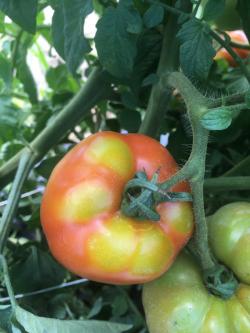 Yellow shoulder is commonly caused by potassium (K) deficiency in tomatoes. Recent surveying by several New England state Extensions has shown that tomatoes, especially high tunnel tomatoes, have very high potassium requirements and crops tend to be deficient. Current nutrient recommendations advise New England growers to fertilize based on the potential yield of your crop (with indeterminate, disease-resistant cultivars planted early into heated tunnels expected to yield more than heirloom or determinate cultivars planted later). See the full recommendations in the high tunnel tomato section of the New England Vegetable Management Guide. One recommendation for K fertility in high tunnel tomatoes is to apply ¼ lb of K/1000 ft2 through the drip every week for 10 weeks, using potassium sulfate fines. In both the field and high tunnels, the following factors can also lead to K deficiency in tomatoes: waterlogged and/or compacted soils, above-optimal nitrogen application rates, excessive application of potassium competitors, and excessively large or dense canopies. Some cultivars, including those with green shoulders that lack the uniform ripening gene, are also more prone to developing yellow shoulder than others. High temperatures and sun can also cause this disorder, both by directly damaging fruit tissue and by inducing water stress that can limit the uptake of K.
Yellow shoulder is commonly caused by potassium (K) deficiency in tomatoes. Recent surveying by several New England state Extensions has shown that tomatoes, especially high tunnel tomatoes, have very high potassium requirements and crops tend to be deficient. Current nutrient recommendations advise New England growers to fertilize based on the potential yield of your crop (with indeterminate, disease-resistant cultivars planted early into heated tunnels expected to yield more than heirloom or determinate cultivars planted later). See the full recommendations in the high tunnel tomato section of the New England Vegetable Management Guide. One recommendation for K fertility in high tunnel tomatoes is to apply ¼ lb of K/1000 ft2 through the drip every week for 10 weeks, using potassium sulfate fines. In both the field and high tunnels, the following factors can also lead to K deficiency in tomatoes: waterlogged and/or compacted soils, above-optimal nitrogen application rates, excessive application of potassium competitors, and excessively large or dense canopies. Some cultivars, including those with green shoulders that lack the uniform ripening gene, are also more prone to developing yellow shoulder than others. High temperatures and sun can also cause this disorder, both by directly damaging fruit tissue and by inducing water stress that can limit the uptake of K.
Blotchy ripening, gray wall, and internal whitening
 These three disorders are not well-understood and tend to be confused with each other. Blotchy ripening is characterized by yellow or orange discolored areas on tomato fruit surfaces. Tomatoes with gray wall have grayish-brown discolorations on the fruit wall and may also exhibit internal browning. Gray wall typically appears on green fruit before ripening. "Gray wall" is the term used when the outer fruit walls turn brown or gray and collapse, compared to "internal whitening", which refers to when the outer and inner fruit walls become white and corky. Factors that increase the severity of these disorders include cloudy weather, wet and cool conditions, high nitrogen, low potassium, and compacted soils. Good irrigation and nutrient management will reduce the risk of these disorders.
These three disorders are not well-understood and tend to be confused with each other. Blotchy ripening is characterized by yellow or orange discolored areas on tomato fruit surfaces. Tomatoes with gray wall have grayish-brown discolorations on the fruit wall and may also exhibit internal browning. Gray wall typically appears on green fruit before ripening. "Gray wall" is the term used when the outer fruit walls turn brown or gray and collapse, compared to "internal whitening", which refers to when the outer and inner fruit walls become white and corky. Factors that increase the severity of these disorders include cloudy weather, wet and cool conditions, high nitrogen, low potassium, and compacted soils. Good irrigation and nutrient management will reduce the risk of these disorders.
Ripening disorders, including yellow shoulder, blotchy ripening, gray wall, and internal whitening, are most prevalent when air temperatures during mid- to late stages of fruit ripening are extreme (e.g., below 60°F and/or above 90°F) or highly variable, when humidity levels remain high, and/or when these conditions prevail and light levels are low. Unfortunately, these are not uncommon conditions in New England and are largely out of our control. Tomato mosaic virus can cause similar symptoms of uneven fruit ripening and should be ruled out as the underlying cause.
Planting tomatoes onto white plastic mulch and using shade cloth can help keep crops cooler and increase marketable yields. Research has shown that a 30% filtering shade cloth increases marketable yields by 20-50%, depending on the year. A 4 ft-wide shade cloth covering even a quarter of the crop canopy is sufficient to achieve this increase in yield, and the cloths may be used for many years.
These disorders are irreversible in fruit that are already symptomatic, but changes to fertility and irrigation can prevent the disorder from affecting younger fruit. Take measures now to ensure that your tomatoes are receiving sufficient and consistent water and nutrients and take note of any abiotic disorders that occur this year to make changes to your fertility and irrigation plan for next year and to help you with variety selection.
--UMass Extension Vegetable Program
News
UMass Extension Fruit Program's Fruit Loop Podcast
MA fruit growers—check out the UMass Extension Fruit Program’s Fruit Loop Podcast, the audio version of the Healthy Fruit newsletter. Each weekly episode covers disease and insect pest updates and integrated pest management recommendations, as well as pruning and growth regulator information. Listen for free wherever you get your podcasts!
Events
Cornell Summer Cut Flower Conference
When: Monday July 29, 11:30am-7pm and Tuesday July 30, 8am-12pm - REGISTRATION CLOSES TOMORROW!
Where: Cornell AgriTech, Geneva, NY
Registration: $30 per day or $50 for both days—If registration fee is cost-prohibitive, please contact Betsy Lamb (eml38@cornell.edu). Click here to register. Please register by Friday, July 26 (TOMORROW!)
Cut flower growers will learn a variety of information including crop scheduling and planning, calculating prices, bulbs as cut flowers, using perennials and natives as cut flowers and other production information such as pest management and integration of methods. This program is part of the Cornell Program Work Team on Cut Flower Production. Click here for more information, including conference schedule.
Water & Climate Change Twilight Meeting at Bardwell Farm – Hatfield, MA
When: Friday, August 2, 2024, 5-7pm, with dinner and discussion to follow
Where: Bardwell Farm, 49 Main St., Hatfield, MA 01038
Registration: Free! Please register in advance so we can order enough food. Click here to register.
Join UMass Extension and CISA for a climate-themed twilight meeting at Bardwell Farm in Hatfield, MA!
- Lisa McKeag will share findings from her recent water quality survey of farms around MA and discuss potential risks and impacts of weather and climate change and rising year-round temperatures on agricultural water quality.
- Harrison Bardwell will show off his new automated irrigation system, and discuss irrigation practices and funded projects around the farm.
- Sue Scheufele will discuss increasing pest risks caused by a hotter climate on vegetable pests including an on-farm trial for managing Phytophthora blight in peppers hosted by Bardwell Farm.
1 pesticide recertification credit is available for this program.
This event is co-sponsored by CISA as part of their Adapting your Farm to Climate Change Series.
Save the Date! UMass Research Farm Field Day - South Deerfield, MA
When: August 13, 2024, time TBD
Where: UMass Crop & Livestock Research & Education Farm, 89 River Rd., South Deerfield, MA
Registration: Coming soon!
Come learn about all the research being done by students and faculty across CNS and by UMass Extension on a tour of the farm. Topics include pollinator habitat, bee health and disease ecology, novel cover cropping strategies, intercropping to reduce greenhouse gas emissions, genetic basis of flowering traits in agriculture, and vegetable variety trials including heat-resistant lettuce varieties for summer production.
Bees and Beyond: Pollinators at the Arboretum
When: Saturday, August 18, 2:00-3:30pm
Where: Arnold Arboretum, 125 Arborway, Boston, MA 02130
Registration: Free. Registration is required. Click here to register.
Join pollinator expert and UMass Extension educator Nicole Bell for a walk through the Arboretum’s meadows to find bees and other pollinators in their natural habitat. Nicole will use a sweep net to find and catch bees in the landscape so participants can see them up close, while we talk about the most common bees found in Massachusetts, where they live and what they eat, and the importance of places like the Arboretum for pollinator conservation.
Field Walk at Siena Farms - Sudbury, MA - CANCELLED
When: Wednesday, August 21, 2024, 4-6pm
Where: Siena Farms, 113 Haynes Rd, Sudbury, MA 01776
Registration: Free! Please register in advance, for food ordering purposes. Click here to register.
Join us for a field walk at Siena Farms! Someone from the farm will discuss their sunflower production, and the UMass Extension Vegetable Program will lead a pest walk. Nicole Bell, UMass Pollinator Extension Educator, will talk about sunflower pollination. Light dinner and refreshments will be served at the end, with plenty of time to talk with fellow growers!
1 pesticide recertification credit is available for this program.
This event is funded by a grant from the Massachusetts Department of Agriculture.
Twilight Meeting: Climate Impacts on Weed Management and Soil Health - South Deerfield, MA
When: Tuesday, October 8, 2024, 4-6pm, with a light supper to follow
Where: UMass Crop & Livestock Research & Education Farm, 89 River Rd., South Deerfield, MA, 01373
Registration: Free! Please register in advance so we can order enough food. Click here to register.
How are climate change and hotter temperatures affecting our soils? Often, practices like reducing tillage and cover cropping are recommended to improve soil health, reduce risk of topsoil loss and enhance resilience to drought and flood—practices that can also affect weed management. UMass Extension will discuss general impacts of climate change on soil health and highlight current research on updating recommendations for planting timing and overwintering survival of cover crop species in MA. Maria Gannett, UMass Extension Weeds Specialist, will relate these strategies to how they can impact weed management.
1 pesticide recertification credit is available for this program.
This event is co-sponsored by CISA as part of their Adapting your Farm to Climate Change Series.
Save the Date! Gaining Ground Farm Tour
When: Thursday, October 17, 2024, 4-6pm
Where: Gaining Ground, 341 Virginia Rd., Concord, MA 01742
Join New Entry and UMass Extension for a farm tour of Gaining Ground Farm in Concord, MA!
Registration and event details coming soon.
Vegetable Notes. Maria Gannett, Genevieve Higgins, Lisa McKeag, Susan Scheufele, Alireza Shokoohi, Hannah Whitehead, co-editors. All photos in this publication are credited to the UMass Extension Vegetable Program unless otherwise noted.
Where trade names or commercial products are used, no company or product endorsement is implied or intended. Always read the label before using any pesticide. The label is the legal document for product use. Disregard any information in this newsletter if it is in conflict with the label.
The University of Massachusetts Extension is an equal opportunity provider and employer, United States Department of Agriculture cooperating. Contact your local Extension office for information on disability accommodations. Contact the State Center Directors Office if you have concerns related to discrimination, 413-545-4800.





